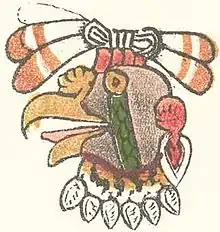cozcacuauhtli
Classical Nahuatl
FWOTD – 22 April 2015
Alternative forms
- cuzcaquauhtli, cozcaquauhtli (obsolete spellings)

The glyph for the day sign cōzcacuāuhtli "vulture", from the Codex Magliabechiano.
Etymology
From cōzcatl (“rounded jewel, necklace bead”) + cuāuhtli (“eagle”).
Pronunciation
- IPA(key): [koːs.kaˈkʷaːʍ.t͡ɬi]
Noun
cōzcacuāuhtli (animate)
- the king vulture, Sarcoramphus papa
- 1555, Alonso de Molina, Aqui comienca vn vocabulario en la lengua castellana y mexicana, f. 11r.
- Aguila de cabeça bermeja.cozca quauhtli.
- A red-headed eagle. cozca quauhtli.
- Aguila de cabeça bermeja.cozca quauhtli.
- 1571, Idem, Vocabulario en lengua castellana y mexicana y mexicana y castellana, f. 6v. col. 1.
- Aguila de cabeça bermeja. cozcaquauhtli.
- A red-headed eagle. cozcaquauhtli.
- Aguila de cabeça bermeja. cozcaquauhtli.
- Idem, f. 27v. col. 2.
- Cuzcaquauhtli. aguila de cabeça bermeja.
- Cuzcaquauhtli. a red-headed eagle.
- Cuzcaquauhtli. aguila de cabeça bermeja.
- 1555, Alonso de Molina, Aqui comienca vn vocabulario en la lengua castellana y mexicana, f. 11r.
- the sixteenth day sign of the Aztec tōnalpōhualli, represented conceptually by this animal.
- 16C: Codex Magliabechiano, f. 13r.
- chi coaçe cuz / ca. coatl. q̃ qui / ere dezir seis a / guilas amarillas.
- chi coaçe cuzca. coatl. [sic] which means “six yellow eagles”.
- chi coaçe cuz / ca. coatl. q̃ qui / ere dezir seis a / guilas amarillas.
- 16C: Codex Magliabechiano, f. 13r.
Hypernyms
- (vulture): tzopīlōtl
References
- Alonso de Molina (1571) Vocabulario en lengua castellana y mexicana y mexicana y castellana, Editorial Porrúa, pages 6v, 27v
- Laurette Séjourné (1981) El pensamiento náhuatl cifrado por los calendarios, Siglo Veintiuno Editores, page 31
- J. Richard Andrews (2003) Workbook for Introduction to Classical Nahuatl, Revised Edition, University of Oklahoma Press, page 650
This article is issued from Wiktionary. The text is licensed under Creative Commons - Attribution - Sharealike. Additional terms may apply for the media files.